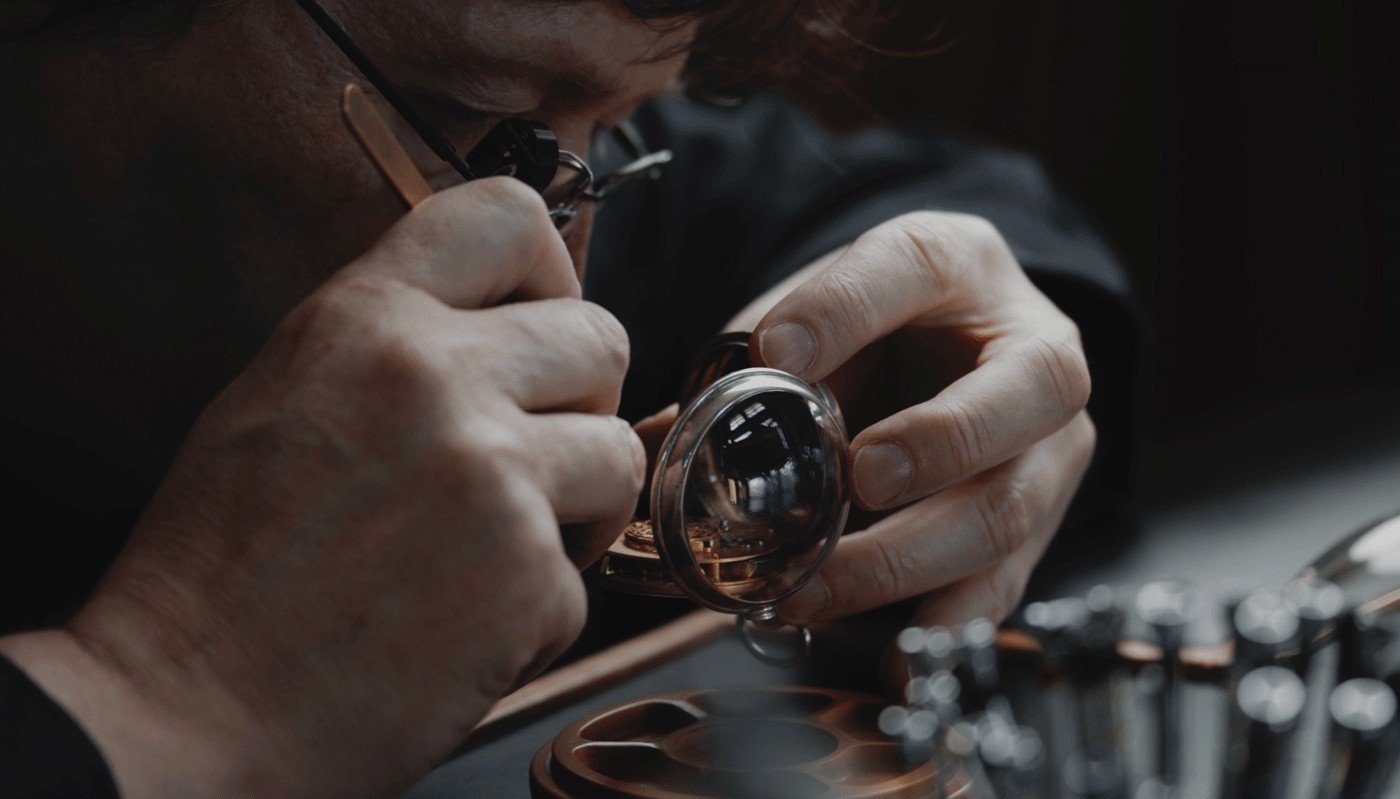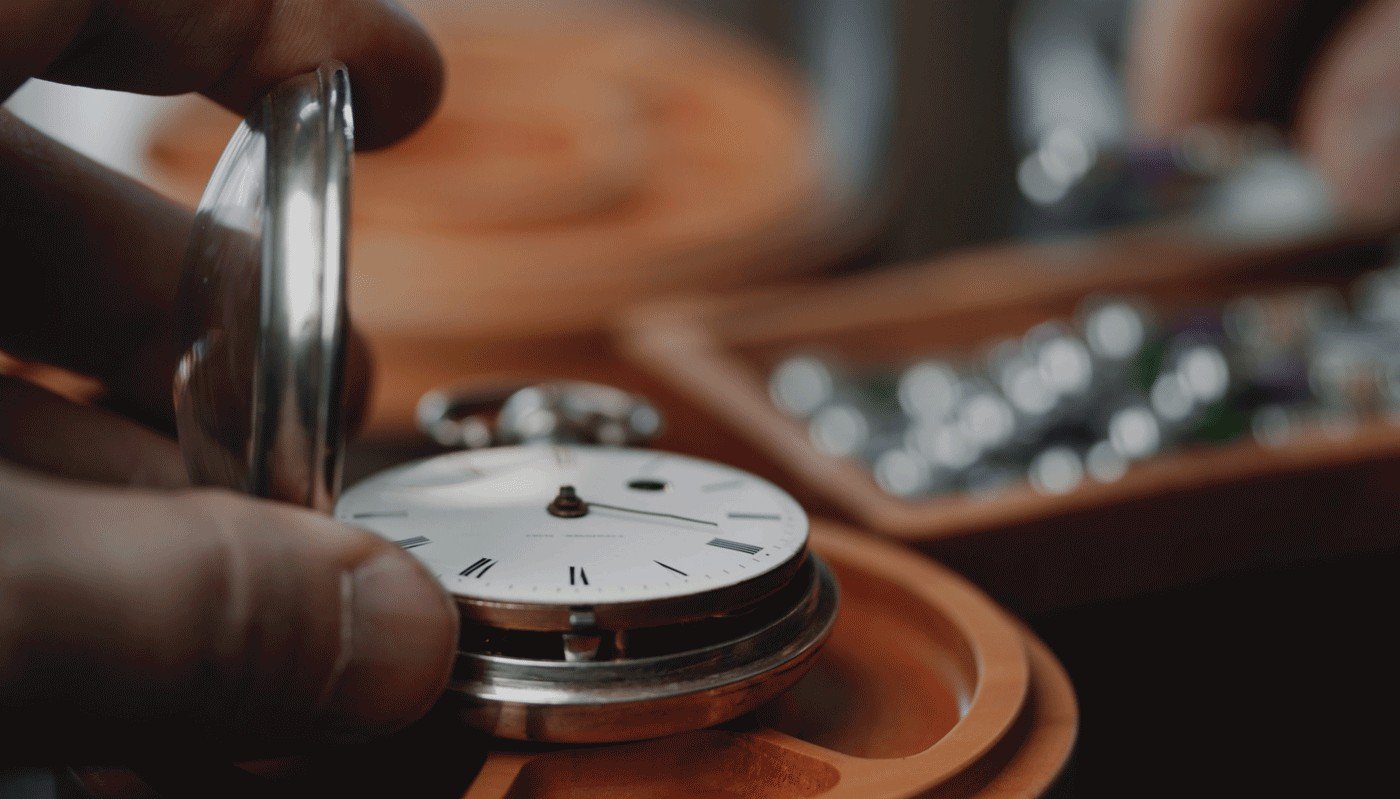We can do more than just read the time, we can experience it in a tangible way.
Pausing amidst the chaos of the everyday to return to the present and distil things down to what is most important. This unusual approach is what guides Haldimann Horology.
Over the centuries, Haldimann has developed a philosophy and mentality uniquely suited to engaging with time in this way. We seek new encounters with time, breaking away from established standards and well-trodden pathways of thought. Since 1642, Haldimann has been creating unique pieces that combine history, art and innovation. The reason our creations are such great examples of expert craftsmanship and distinctive flair is because they are shaped by our values. These values are rooted in the long-standing traditions that we hold dear. To this day, Haldimann makes only mechanical movements and timepieces exclusively in Switzerland: timepieces that inspire people all over the world to discover time anew.

We want to work at the very limit of what the human hand is capable of.
AS A MANUFACTURE, WE CAN ONLY DO THIS, IN THE TRUE SENSE OF THAT WORD, BY USING, MACHINES AND INSTRUMENTS THAT "LEND A HAND" TO THE HAND.
Computer-controlled machines would make it impossible for us to truthfully make this key claim. The warmth of the master horologist’s hand merges with the subtlety of its movements to create truly impressive work. Every stage, from the raw materials to the first melodic ticking of the watch, is imbued with this hand-made essence. An essence that the eventual owner of the watch carries with them on their wrist. From there, it enters into their perception and, from there, into them.


In essence , our creations are alive.
Owners of our timepieces often tell us that they forget all about time when looking at a Haldimann.
In fact, Haldimann timepieces are dedicated not so much to showing the time as depicting its passage. Our timepieces sing, speak and dance. Their melodies and speech arise from an orchestrated interplay between many small, unique parts. Melody and speech can also be found in the vibrations of the movement and the overall appearance of the object. The timepiece develops a resonance with the environment and the owner, evident in the “warmth” of the movement, its decelerating effect and its serenity – it feels like an old friend.

The aim is to exude a flawless aesthetic that stands up to long, penetrating gazes.
Mechanical perfection demands a formal quality that allows the unique character of the creation to be expressed over the course of time without the unnecessary distractions that different times can bring. We produce simple, harmonious, timeless and elegant timepieces – pieces that, once encountered, are impossible to resist.

The work of our own hands in the truest sense, each timepiece is a combination of many tiny and unique pieces , painstakingly put together.
Each timepiece takes a long time to create, and this builds a close relationship between the watchmaker and “their” watch. It is this relationship that brings the watch to life. This vitality is then transferred to the owner. The relationship we build with our creations is at the core of what we do. The technical means by which we build this relationship are purposely kept in background, yet their essence is woven into the work. This approach is what makes each of Haldimann Horology’s creations unique.


Their value stems from their rarity and the creativity that goes into them.
It goes without saying that Haldimann timepieces are made from the most precious of materials.
They are sophisticated, yet understated. The long process of becoming a Haldimann timepiece, which takes place almost 100% in-house over a period of months, leads to a kind of natural selection along the way and to a limitation of the number of pieces available to be passed down through the generations. There can only be a few. There will only be a few. As a result, the worth of a Haldimann creation lies entirely in the value of the work—not in advertising. This value is timeless.


A Haldimann timepiece must amplify the positive emotions of its owner. It must inspire, enrich and anchor them.
Owners of Haldimann timepieces tell stories of shared passion, of love for people or for their watch, of pausing in time and forgetting time, of pleasant ripples on the skin or in the memory, of memories triggered by a glance at the moving sculpture. To many, our watches are “art for the wrist”.

The owner of a Haldimann becomes an inheritor of the artistic and scientific tradition of the “Antikythera”.
The tradition was established around 100 BC. It is an artistic and scientific tradition in which ideals, knowledge and skills are passed down to family. This tradition has shaped our manufacture.
A Haldimann makes this tradition tangible and makes the owner of the timepiece aware of their own tradition. The timepiece transmits the values it represents through its presence: the first time a young person winds the mechanical hand-wound movement, they become part of our tradition. With the first movement on the manual winding mechanism, the passing down of tradition, the inheritance, begins.
Go to collectionTradition is what motivates us.
It has also gifted us with something special that we want to cherish.
A legacy stretching back to 1642—a legacy that we have a duty to continue to discover and develop. This legacy connects us to Abraham Louis Breguet, Antide Janvier and John Harrison. This is what drives us: a legacy made up of the combined experience, ingenuity and passion of several generations. Time without end. Thousands of works in the Haldimann Library attest to this. This library is a cultural space that is dedicated to the transmission and dissemination of more than 800 years of horological tradition. Therefore, this space is also available for researchers or those with a passion for horology to use.
Haldimann is the oldest family-run independent Swiss watch manufacture still owned by the family that gives the company its name. The benefits of full creative freedom, of maintaining the highest quality standards and of keeping all production exclusively in-house have been evident in every single timepiece and movement we have produced over the centuries.


1380
Hänsli an der Halden in Langnau
1410
Hänsli Haldimann buys the Horben Estate
1440
Niclaus Haldimann
1480
Peter Haldimann
1525
Hans Haldimann
1550
Christian Haldimann
1577
Hans Haldimann at Schwendimatt in the Bowil district. Patriarch of the Bowil line
1619
Christian Haldimann
1642
Bill of sale. First mention of the Haldimann Clockmakers Ulrich and Hans Haldimann, father and son, at Horben Hans Haldimann, Horologist, at Horben
1647
Emigration of the Le Locle and Yverdon branches of the family
1658
Hans Haldimann
1687
Hans Haldimann
1735
Hans Haldimann
1765
Ulrich Haldimann
1806
Peter Haldimann
1837
Johannes Haldimann
1878
Christian Haldimann
1902
Christian Haldimann
1937
Werner Haldimann, Vater
1964
Beat Haldimann Born in Oberdiessbach Emmental, Canton of Bern, Switzerland, grew up in Uetendorf and Thun
1985
Beat Haldimann School Clock
1989
Natalie Xenia
1991
Emergence of a new branch in the family tradition dating back to 1642. Foundation of Haldimann Horology as a company
1992
First attempts at resonance with regulators
1993
First attempts at resonance with wristwatches
1995
Regulator with magnetic field transmission
1998
Niklaus Anton
1999
Presentation of the H104 "three-rod pendulum" second regulator
2000
Iris Olga
2000
Awarding of a patent for the “Haldimann Detached Escapement” Presentation of the first double regulator “H101 Resonance/Modern” 200 years after Antide Janvier and Abraham-Louis Breguet
2002
World debut of the “H1 Flying Lyra”, the first central tourbillon to float above the dial. Selected as one of the 20 most important watchmakers in the world by the jury of “Chronos”, Germany and “Watch Time”, USA
2003
Delivery of the specially commissioned double regulator “H101 Resonance Classic/Modern” for the permanent exhibition at the Musée International d'Horlogerie in La Chaux-de-Fonds, Switzerland. The H1 is awarded the “Goldene Unruh”, Special Technology Prize (1st prize awarded by the jury of experts for Innovation of the Year 2003).
2005
World debut of the “H2 Flying Resonance”, the first double tourbillon to float above the dial, at the Baselworld Messe trade fair.
2007
Opening of the Antikythera Library, which chronicles the art of horology starting from 100 BC in Greece all the way to the present. A unique library of unmatched quality.
2008
World debut of the sculpture “H8 Flying Sculptura”, the first wearable sculpture for the wrist.
2009
Beat Haldimann receives the Prix Gaïa—considered the “Nobel Prize” of horology—in recognition of his life's work. The Prix Gaïa is the highest award that can be bestowed upon a person and their work in the world of horology. Laudation delivered by: Lutz-Peter Nolte, Prof. Dr.
2010
Presentation of the “H3 Flying Sculptura” with minute repeater
2012
World debut of the sculpture “H9 Reduction”—The power of reduction demonstrated by this “Black Hole” for the wrist.
2013
World debut of the first wristwatch with a central balance and hours and minutes from the centre: H11
2014
H11 with a small seconds hand and central balance Delivery of the specially commissioned “H1 Flying Central Tourbillon” for the permanent exhibition at the Musée International d'Horlogerie in La Chaux-de-Fonds, Switzerland.
2016
H102 Regulator Small with patented Haldimann Escapement
2018
H1 Stars with diamonds on the hands and flying central tourbillon
2019
H3 Flying Sculpture with Minute Repeater
2021
H51 Time-Hora—The first timepiece to put time into perspective. Featuring the Bürgi parameter and a resonating half-second double pendulum as a tribute to Jost Bürgi. www.bürgi.swiss
1380
Hänsli an der Halden in Langnau
1410
Hänsli Haldimann buys the Horben Estate
1440
Niclaus Haldimann
1480
Peter Haldimann
1525
Hans Haldimann
1550
Christian Haldimann
1577
Hans Haldimann at Schwendimatt in the Bowil district. Patriarch of the Bowil line
1619
Christian Haldimann
1642
Bill of sale. First mention of the Haldimann Clockmakers Ulrich and Hans Haldimann, father and son, at Horben Hans Haldimann, Horologist, at Horben
1647
Emigration of the Le Locle and Yverdon branches of the family
1658
Hans Haldimann
1687
Hans Haldimann
1735
Hans Haldimann
1765
Ulrich Haldimann
1806
Peter Haldimann
1837
Johannes Haldimann
1878
Christian Haldimann
1902
Christian Haldimann
1937
Werner Haldimann, Vater
1964
Beat Haldimann Born in Oberdiessbach Emmental, Canton of Bern, Switzerland, grew up in Uetendorf and Thun
1985
Beat Haldimann School Clock
1989
Natalie Xenia
1991
Emergence of a new branch in the family tradition dating back to 1642. Foundation of Haldimann Horology as a company
1992
First attempts at resonance with regulators
1993
First attempts at resonance with wristwatches
1995
Regulator with magnetic field transmission
1998
Niklaus Anton
1999
Presentation of the H104 "three-rod pendulum" second regulator
2000
Iris Olga
2000
Awarding of a patent for the “Haldimann Detached Escapement” Presentation of the first double regulator “H101 Resonance/Modern” 200 years after Antide Janvier and Abraham-Louis Breguet
2002
World debut of the “H1 Flying Lyra”, the first central tourbillon to float above the dial. Selected as one of the 20 most important watchmakers in the world by the jury of “Chronos”, Germany and “Watch Time”, USA
2003
Delivery of the specially commissioned double regulator “H101 Resonance Classic/Modern” for the permanent exhibition at the Musée International d'Horlogerie in La Chaux-de-Fonds, Switzerland. The H1 is awarded the “Goldene Unruh”, Special Technology Prize (1st prize awarded by the jury of experts for Innovation of the Year 2003).
2005
World debut of the “H2 Flying Resonance”, the first double tourbillon to float above the dial, at the Baselworld Messe trade fair.
2007
Opening of the Antikythera Library, which chronicles the art of horology starting from 100 BC in Greece all the way to the present. A unique library of unmatched quality.
2008
World debut of the sculpture “H8 Flying Sculptura”, the first wearable sculpture for the wrist.
2009
Beat Haldimann receives the Prix Gaïa—considered the “Nobel Prize” of horology—in recognition of his life's work. The Prix Gaïa is the highest award that can be bestowed upon a person and their work in the world of horology. Laudation delivered by: Lutz-Peter Nolte, Prof. Dr.
2010
Presentation of the “H3 Flying Sculptura” with minute repeater
2012
World debut of the sculpture “H9 Reduction”—The power of reduction demonstrated by this “Black Hole” for the wrist.
2013
World debut of the first wristwatch with a central balance and hours and minutes from the centre: H11
2014
H11 with a small seconds hand and central balance Delivery of the specially commissioned “H1 Flying Central Tourbillon” for the permanent exhibition at the Musée International d'Horlogerie in La Chaux-de-Fonds, Switzerland.
2016
H102 Regulator Small with patented Haldimann Escapement
2018
H1 Stars with diamonds on the hands and flying central tourbillon
2019
H3 Flying Sculpture with Minute Repeater
2021
H51 Time-Hora—The first timepiece to put time into perspective. Featuring the Bürgi parameter and a resonating half-second double pendulum as a tribute to Jost Bürgi. www.bürgi.swiss